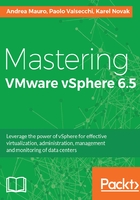
Best practices
A best practice is a method, technique, or approach that is usually generally accepted because it produces better or more reliable or repeatable results. You can consider it as a standard, suggested, or recommended way of doing some things. But it’s not a law or a diktat that must be universally followed without any thought. Using best practices requires you to know the background of the best practice and how it applies to your specific situation and design.
Anyway, best practices remain a useful pattern for the design of virtual infrastructures in a proper way; as also for validating the design itself, in order to be compliance with possible future support feedback or requests.
You can find several best practices for VMware in different documents, such as:
- Performance Best Practices for VMware vSphere 6.5: https://www.vmware.com/techpapers/2017/Perf_Best_Practices_vSphere65.html
- VMware vCenter Server 6.5 High Availability Performance and Best Practices: https://www.vmware.com/content/dam/digitalmarketing/vmware/en/pdf/techpaper/vcha65-perf.pdf
And also in several Knowledge Base (KB) articles, such as:
- Best practices and advanced features for VMware High Availability: https://kb.vmware.com/kb/1002080
- Best practices for upgrading to vCenter Server 6.5: https://kb.vmware.com/kb/2147686
Remember that there are also vendor specific best practices, like for storage or networking (but also for servers); where VMware may have a generic suggestion (such as, in storage, the multipath choice), the specific vendor will usually have more detailed information for the configuration part. For this reason, try to apply the more specific recommendations, but always check that there aren’t any conflicts.